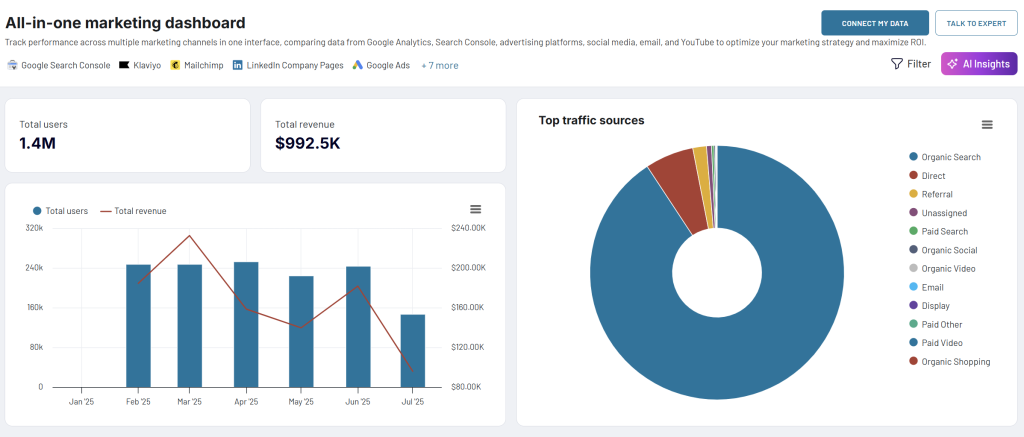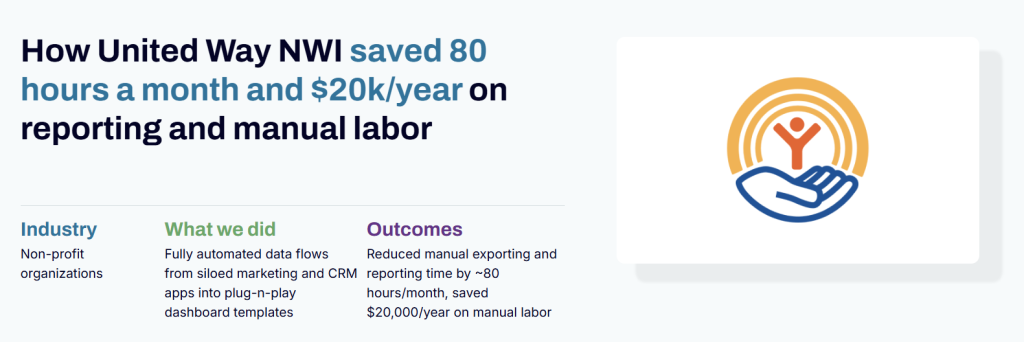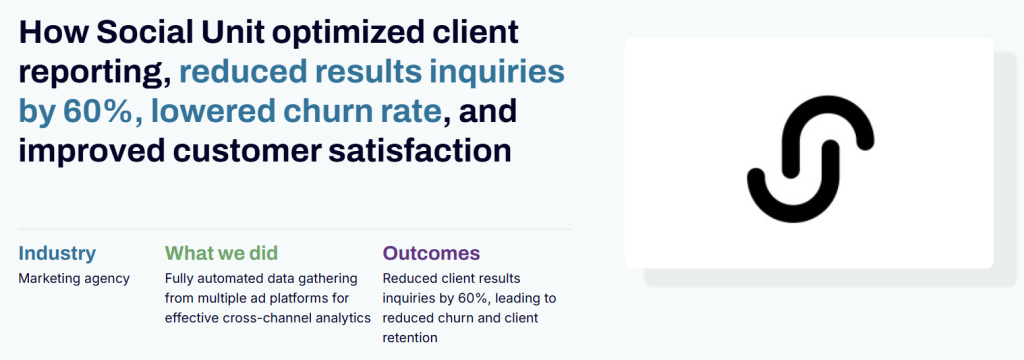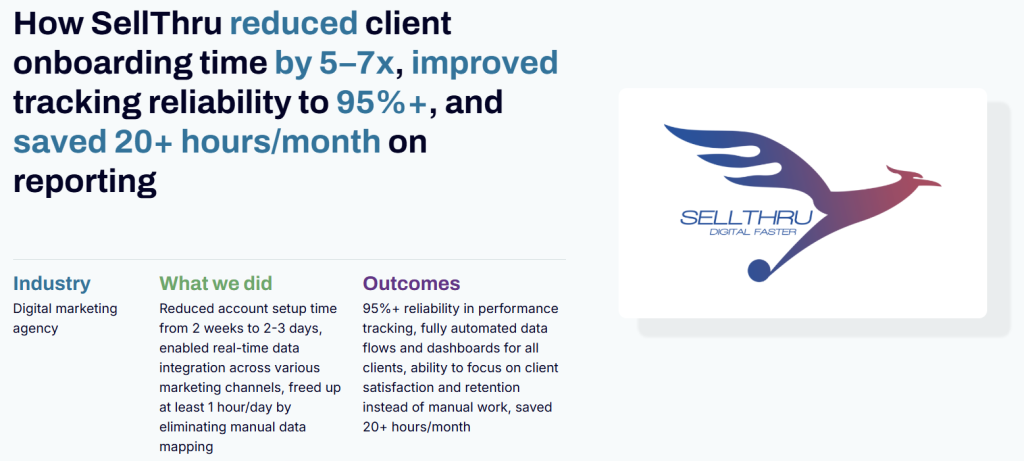The Hidden Price of Manual Data Work: Why Marketing Teams Need Automation
It’s 10:00 AM, and your team’s stand-up just ended.
You’ve got five tabs open, three spreadsheets half-filled, and a Slack message from your manager asking for “a quick performance summary” from last week’s campaigns. You know the drill: dig into GA4, export Meta Ads data, clean up a Mailchimp CSV, manually stitch it all together. You know it’s going to take half of your day. Again.
According to a global survey by Treasure Data, marketing teams spend an average of 14.5 hours per week managing and collecting customer data. 18% report spending over 20 hours a week on this task.
To put that in perspective, assuming a 40?hour work week, that’s over 36% of their time just on data collection and preparation, not analysis or strategy. This, of course, impacts productivity and the efficiency of marketing efforts. If your team spends almost 40% of its time collecting and preparing data, that team doesn’t have enough time to create and implement data-driven campaigns.
This isn’t just inefficiency—it’s a strategic vulnerability that’s costing companies millions.
In this article, we are going to discuss the real cost of manually collecting marketing data and why automation is mandatory for top-performing companies.
Time lost, potential wasted: The cost of lost productivity
Despite living in the era of AI and automation, many marketing teams still spend hours manually collecting performance data across platforms, checking dashboards, exporting spreadsheets, cleaning numbers, and assembling reports by hand. On average, marketers spend between 6 to 10 hours per week on this task, with some teams spending over 14 hours, according to multiple industry surveys.
That’s up to 36% of a workweek spent on repetitive, low-value tasks, not on campaign ideation, experimentation, or performance optimization.
But the real cost isn’t just in hours lost. It’s in what’s not getting done.
While your team copies and pastes metrics, your competitors are launching three new ad variants, testing different audience segments, and reallocating budget to high-performing channels in real-time. By the time your weekly report is ready, they’ve already optimized twice and captured market share you’re still measuring.
This creates a compounding competitive disadvantage. Gitnux reports that data-driven companies are 6X more likely to be profitable year-over-year, yet many marketing teams remain trapped in manual workflows that slow everything down.
This kind of manual data labor creates a bottleneck that slows everything else down:
- Delayed insights mean missed trends and slower response times
- Reporting lag causes budget reallocation delays and wasted spend
- Inconsistent data leads to poor alignment between marketers and stakeholders
Data-driven organizations are 23× more likely to acquire customers, 6× more likely to retain them, and 19× more likely to be profitable, according to Forbes. Yet despite the clear upside, many marketing teams still spend hours manually collecting data before they can act on it.
In fast-moving markets, agility is everything. When teams are bogged down by data prep, they miss windows of opportunity, and their marketing performance suffers.
So what’s the alternative?
The market offers several automation approaches, each suited to different team sizes and technical capabilities. Some companies invest in custom-built API integrations. Others stitch together tools with data connectors like Zapier or Microsoft Power Automate.
Larger enterprises might implement comprehensive data platforms like Snowflake or Databricks. Mid-market teams often turn to specialized marketing data tools like Fivetran or similar solutions. These work to a point, but often require technical expertise or only solve part of the puzzle.
The real solution isn’t hiring more analysts; it’s removing the bottleneck altogether.
That’s where Coupler.io comes in. As a no-code data integration and AI analytics platform, Coupler.io offers data connectors for marketing platforms like GA4, Meta Ads, and HubSpot. You can integrate data from them directly with destinations like Google Sheets or BigQuery, on a schedule you define. No manual exports, no CSV export/import. Additionally, you can clean up your data by hiding columns, creating new ones, filtering and aggregating data, and more.
Be it PPC reporting or marketing agency reporting, the automation by Coupler.io will save your time and hence money. Check out this interactive form to see how easy it is to automate data flows in Coupler.io.
With auto-refreshing pipelines, your team can finally stop wrangling data and start acting on it. Moreover, Coupler.io supports both incoming and outgoing webhooks for event-driven automation.
And when your data flows automatically, you can do more than just report; you can optimize.
The tool stack problem: too many sources, too little clarity
Since we talked about the All-in-one marketing dashboard, we can’t help but mention the number of tools marketers use on a daily basis. Today’s buyers don’t convert after seeing a single ad or email, they interact with 8 or more touchpoints across multiple channels before making a purchase. But most marketing teams can’t see that full journey, because the data is spread across too many platforms that don’t talk to each other.
That’s the reality of the modern marketing stack: powerful, but painfully fragmented. According to the 2024 Marketing Technology Landscape Supergraphic, there are now over 13,000 distinct MarTech solutions available globally—a number that has doubled since 2020 and grown 30× since 2011.
In practice, a typical B2B marketing team might use:
- Salesforce for CRM
- HubSpot for content and email nurturing
- Google Analytics for web traffic
- LinkedIn Ads for lead generation
- Mailchimp for newsletters
- Meta Ads Manager for paid social
That’s six tools, six data formats, and six dashboards, none of which are naturally integrated.
If your team uses 10 platforms and spends just 30 minutes per platform per day, that’s 25 hours per week lost just accessing, downloading, and reconciling data.
And it’s not just about time—it’s about clarity. In a recent industry survey, over 65% of marketing leaders reported using more than six different platforms to manage their campaigns. While each tool serves a specific purpose, the lack of integration between them creates blind spots and slows down strategic action.
This fragmentation leads to:
- Slower reporting and analysis
- Missed optimization opportunities
- Inconsistent KPIs between teams
- Eroded stakeholder trust in performance data
In today’s world of complex, cross-channel customer journeys, teams need more than spreadsheets; they need a single source of truth that brings everything together in real time.
That’s why marketers are turning to solutions like Coupler.io. Rather than adding yet another tool, Coupler.io helps your existing stack finally work together. It automates the flow of data from platforms like GA4, Meta Ads, HubSpot, and LinkedIn into a central workspace like Google Sheets or BigQuery—no code, no engineers required.
Automation of ETL for marketing data is just one value Coupler.io offers. To act on the data, you can use ready-made dashboards that plug directly into your synced data, giving you immediate visibility into performance without starting from scratch.
Whether you’re tracking ad spend, content ROI, or traffic sources, dashboards like the All-in-one marketing dashboard help you spot trends, compare channels, and make faster decisions—all in one place.

This dashboard provides a complete overview of your marketing performance. It integrates data from over 10 sources. With just a few clicks, you can compare the performance of your ads, email, and content marketing campaigns. This marketing reporting solution highlights the top traffic sources, the total revenue, and the ad performance, all in one dashboard. Moreover, it’s equipped with AI insights, a feature that delivers trends, key findings, and recommendations from your data in seconds.
By the way, Coupler.io also provides a similar dashboard but for social media reporting.
Handling multiple marketing tools is just the tip of the iceberg. When teams rely on manual processes to collect, align, and report on data, human error becomes not just likely—but inevitable. According to the Journal of Accountancy, manual data entry has an average error rate between 1% and 5%. And as the number of platforms increases, so does the complexity—and the risk.
A report from the International Journal of Human-Computer Interaction confirms that error rates rise significantly when individuals enter data across multiple platforms. In marketing, that means tracking spend in Meta Ads, conversions in Google Analytics, leads in HubSpot, and campaign names in Mailchimp—each with its own taxonomy, timezone, and formatting.
And these aren’t just typo-level mistakes. In complex, multi-platform setups, errors often stem from structural inconsistencies that undermine your entire performance picture. Common issues include:
Misaligned attribution models
One platform attributes conversions to last-click, another uses a data-driven model, and a third assigns credit to the first touch. Without reconciliation, this leads to inflated results for certain channels, or worse, underreporting of key contributors. For example, email may look like it’s underperforming simply because its value is captured elsewhere. These inconsistencies make it nearly impossible to make informed channel optimization decisions.
Currency conversion mistakes in global campaigns
Managing spend across regions often involves combining budgets from USD, EUR, GBP, or local currencies like JPY or INR. A missed exchange rate update or inconsistent conversion logic can distort performance comparisons, inflate reported revenue, or understate CAC. A campaign that looks profitable in one report might actually be operating at a loss when accurately converted.
Timezone discrepancies across platforms
Facebook Ads reporting in local time, GA4 in UTC, and your internal CRM in EST. If these aren’t normalized, daily performance reports can double-count or miss key data, leading to misleading trends. A campaign might appear to have dropped in performance on a given day, not because it actually underperformed, but because time-aligned data wasn’t properly synchronized.
Even small discrepancies can compound into massive issues. One wrong number might not break your campaign, but a chain of minor mismatches across platforms can.
This is the compound error effect:
Errors don’t just cost money—they erode trust in your data. When stakeholders begin doubting the numbers, they start relying on gut instinct instead of evidence. And just like that, the competitive advantage of data-driven marketing disappears.
According to a recent industry analysis, the average cost of a single data entry error ranges from $50 to $150, depending on how far the mistake travels before it’s caught. In a typical weekly reporting cycle with hundreds of data points in play, even a 1% error rate could result in hundreds or thousands of dollars in misallocated budget, not to mention hours wasted in rework and damage control.
If a marketing team managing $100,000/month in ad spend misattributes just 5% of spend due to currency mismatch or platform lag, that’s $5,000 lost monthly, or $60,000 a year in preventable inefficiency.
By automating not just data collection but also transformation across platforms like GA4, Meta Ads, and HubSpot, Coupler.io eliminates the manual processes where most of these errors originate. No more copy-pasting between exports, no more stitching together mismatched attribution models or timezone formats.
With Coupler.io’s scheduled syncs to destinations like Google Sheets, Excel, or BigQuery, marketers can ensure their data is not only up to date but also consistent, standardized, and trustworthy. That means fewer mistakes, faster corrections, and greater confidence when making performance decisions.
For example, imagine an e-commerce brand running global campaigns across the US, UK, and Australia. Their analyst manually combines weekly data from Meta Ads and GA4, but forgets to convert the UK’s GBP and Australia’s AUD to USD before reporting. The ROAS looks inflated, and the budget is reallocated to underperforming regions. Over the course of a quarter, this error contributes to $18,000 in misallocated spend.
Coupler.io enables the marketing team to set up automated flows that normalize currency values, unify attribution models, and align time zones before the data hits their dashboards. The result: no costly errors, no misleading reports, just clean, reliable data that drives smarter decisions.
It’s not just about saving time, it’s about protecting accuracy, preserving trust, and keeping your marketing strategy rooted in data, not guesswork.
Automate marketing reporting with Coupler.io
Get started for freeAutomation is mandatory – and it delivers real ROI
Marketing teams are under constant pressure to do more with less and faster. Manual data collection slows everything down, from campaign analysis to decision-making. Automation solves that problem by removing repetitive tasks and giving senior marketers more time for strategic thinking, performance reviews, and creative execution.
According to McKinsey & Company, businesses using automated data collection report up to a 30% increase in operational efficiency and a 20% reduction in data processing errors. When marketing decisions depend on accurate, real-time data, cutting out mistakes and delays becomes a competitive advantage.
The benefits go beyond internal workflows. 77% of brands report higher conversion rates after implementing marketing automation, and 63% outperform competitors because of it. Automation unlocks faster reporting, tighter feedback loops, and the ability to act on data the moment it’s available.
For teams thinking about ROI, the payoff is clear. Research from Woopra and Marketo shows a 34% average increase in ROI from automation, with 76% of teams breaking even within one year, and 44% in just six months.
Data automation isn’t a cost center. It’s a growth driver. Coupler.io helps you unlock that growth with speed, accuracy, and control just like it did for PlumbBooks. It’s not a marketing data automation case. However, the Coupler.io-driven automation enabled this bookkeeping service to increase its revenue by 40%!
Of course, many marketing teams are already thinking about automation, but hesitate when it comes to implementation.
What about the learning curve? The cost? The effort to integrate all your tools? These concerns are valid, especially for lean teams without dedicated data engineers.
The truth is, automation doesn’t happen all at once. Most companies evolve through stages:
- Manual: Spreadsheet exports and ad hoc reports
- Semi-automated: Platform-native exports and dashboards
- Fully integrated: Unified, automated data pipelines feeding live dashboards and performance alerts
There are several ways to move up this maturity curve. Some teams tap into built-in APIs offered by platforms like HubSpot or Meta Ads. Others use tools like Zapier or Microsoft Power Automate to stitch workflows together. Larger organizations may invest in custom integrations or full-stack data platforms.
Coupler.io fits right in the middle, offering a flexible, no-code alternative for teams who want full automation without the overhead of engineering support.
It connects tools like GA4, Meta Ads, and HubSpot directly to destinations like Google Sheets, Excel, or BigQuery, and allows marketers to schedule automatic syncs, apply transformations, and keep dashboards up to date, without touching a line of code. Its scalable architecture makes it a fit for startups, agencies, and enterprise teams alike.
It only takes a few minutes to integrate your desired marketing app into your preferred destination. Check it out in this interactive form yourself.
That’s it! In a matter of minutes, you can collect data from over 70 apps and get fresh data, updated on a schedule, for reporting in the chosen destination. No more manual exports and reports created with outdated information.
Data security in automation
Security isn’t just a technical concern, it’s a foundational requirement for modern marketing operations. With nearly 94% of organizations reporting that customers would not buy from them if their data weren’t properly protected, demonstrating strong security and compliance isn’t optional; it’s business-critical.
Additionally, compliance matters: 98% of organizations work with at least one third-party vendor that has experienced a data breach, highlighting the scale of the threat and the importance of tools being GDPR- and SOC?2-compliant.
Marketing teams today work with increasingly complex datasets: campaign metrics, customer behavior, lead scoring, CRM events. These flow through multiple platforms, across departments, and in many cases, across borders. Regulatory frameworks like SOC 2 Type II, GDPR, and CCPA establish strict guidelines around data processing, storage, and access. Failing to meet these standards doesn’t just result in fines, it undermines customer trust and limits growth opportunities.
Beyond regulatory compliance, secure automation also requires clear governance and technical reliability. That means knowing:
- Who can access your data and when
- Where your data is stored and how it’s transmitted
- How often your pipelines sync and whether they fail silently or alert your team
- Whether you can export and transfer your data freely, without vendor lock-in
If these controls aren’t in place, organizations face risks like inconsistent reporting, unauthorized access, or delays in responding to data subject requests—all of which introduce real financial and operational costs.
Many companies also underestimate the cost of manual workflows from a security standpoint. Shared spreadsheets and ad hoc exports may seem harmless, but they increase the chance of misalignment, data leakage, and unintentional noncompliance. Without automation, governance becomes reactive instead of proactive.
That’s why selecting a secure and flexible automation platform is a strategic decision. A robust solution should include:
- Encryption in transit (TLS) and at rest (AES-256)
- Role-based access controls and audit logs
- GDPR and CCPA readiness
- SOC 2 certification
- Transparent scheduling and error handling
- Easy data export and integration options
Coupler.io delivers on all of these requirements. With compliance baked into its architecture and a no-code approach to pipeline creation, it enables marketing teams to automate confidently, without compromising data integrity, privacy, or control.
But how does this look in practice? Let’s examine a real-world example to see exactly how Coupler.io transforms marketing workflows.
Success stories: Automation in action
Whether you’re a nonprofit with limited resources, a growing agency, or a global enterprise, the challenge remains the same: too much manual work, too little strategic time. Here’s how teams across different sectors and scales solved this problem:
Mission-driven organizations: How United Way NWI saved $20K and unlocked $50K+ in donations
United Way of Northwest Indiana is a nonprofit organization supporting education, financial stability, and health initiatives across communities. Like many mission-driven teams, their marketing and fundraising efforts rely heavily on accurate, up-to-date data from multiple sources—including Facebook Ads, Google Analytics, Search Console, and their CRM.

The challenge
The team was spending up to 80 hours each month manually pulling and compiling campaign data for internal reports and board meetings. Limited access to real-time performance metrics slowed down decision-making, made it harder to track donor engagement, and created inefficiencies that drained both time and budget—resources that could have been directed toward their community mission.
The solution
United Way turned to Coupler.io to automate their data flows and unify reporting across platforms. The no-code setup allowed the team to easily integrate their CRM with marketing and web analytics tools, creating automated dashboards that provided a centralized, real-time view of all fundraising and awareness efforts.
The results
Coupler.io helped United Way unlock more time and funding for what really matters—their mission:
- Eliminated up to 80 hours/month in manual reporting, translating into $20,000+ in annual cost savings
- Empowered faster response times to campaign trends and improved donor engagement
- Helped identify high-performing strategies that contributed to $50,000+ in additional donations
Using Coupler.io to centralize and automate data has been a game-changer. We now have one source of truth, and our reports are always up-to-date and reliable. — Adam O’Doherty, President & CEO at United Way NWI
Performance agencies: How ClaritySeed delivers client reports 5x faster
ClaritySeed is a performance marketing agency focused on helping startups and scale-ups maximize ROI across digital channels. Known for its strategic approach to growth, ClaritySeed relies on rapid feedback loops and high-frequency reporting to guide campaign decisions and prove value to clients.

The challenge
As client portfolios expanded, the team found themselves overwhelmed by the time-consuming process of aggregating data from multiple sources like Facebook Ads, GA4, and Google Ads. Building custom dashboards and preparing weekly reports often took 6 hours per client and left little time for campaign analysis or optimization—the high-value work that drives results.
The solution
ClaritySeed adopted Coupler.io to automate all recurring reporting tasks. With native integrations and a simple setup process, the team connected their ad and analytics platforms in minutes rather than hours, creating automated workflows that handle all data updates and ensure reports are always fresh and client-ready.
The results
Automation gave the ClaritySeed team back more than just time—it enabled better decision-making and faster growth:
- Cut report delivery time from 6 hours to just 1 hour
- Saved 10+ hours per week across the team, freeing time for strategy and experimentation
- Improved data reliability and client satisfaction through always-on dashboards
Coupler.io helped us reclaim time and focus on strategic work. It’s super easy to use, even if you’re not technical. A perfect fit for agencies that care about speed and scale. — Ahmed H., CEO at ClaritySeed
Social Media specialists: How Social Unit cut reporting time by 90%
Social Unit is a social media and digital marketing agency serving a global portfolio of clients. They specialize in managing multi-platform ad campaigns across Meta, TikTok, Google, and more—delivering tailored performance insights for each brand across diverse markets and audiences.

The challenge
The team spent 2–3 days each week building performance reports manually, a process that involved exporting and merging data from multiple ad platforms. This delay often led to stale insights, reduced transparency with clients, and a constant flood of client inquiries requesting up-to-date numbers—creating additional work that pulled the team away from optimization tasks.
The solution
With Coupler.io, Social Unit built automated pipelines to collect, normalize, and visualize all campaign performance data in one centralized location. Their client reporting dashboards now update automatically, offering clients a real-time window into campaign health and ROI without any manual intervention.
The results
Coupler.io didn’t just speed up reporting—it transformed client relationships and operational efficiency:
- Reduced reporting time by 90%, from days to less than 30 minutes
- Cut client update requests by 60%, improving communication and trust
- Enabled the team to reallocate time toward campaign optimization and strategic planning
Coupler.io gave us a clear edge. Our reports are always ready, and clients get the insights they need instantly. It’s a huge time saver and helps us retain more business. — Yevheniia Hrabina, CMO at Social Unit
Growing agencies: How SellThru eliminated 20 hours of manual work monthly
SellThru is a leading digital marketing agency in the GCC region, known for delivering growth through data-driven marketing strategies. Unlike most agencies, SellThru is structured to function like an in-house marketing team, combining acquisition and retention strategies to provide holistic, personalized support for its diverse client base.

The challenge
Managing performance data across multiple marketing platforms quickly became a bottleneck. The SellThru team needed a unified view of growth metrics, particularly last-click attribution data across all channels. Existing tools focused only on visualization, falling short when it came to integrating and transforming raw data from platforms like GA4, Meta Ads, and others. Manual data mapping and dashboard setup consumed hours of valuable time and limited scalability.
The solution
After evaluating tools like Supermetrics, Porter, and Funnel, SellThru chose Coupler.io for its flexibility, cost-effectiveness, and scalability. Coupler.io offered unlimited data sources, unlimited user seats, and seamless integrations without code, making it an ideal fit for the agency’s high-touch client reporting needs.
Using Coupler.io, SellThru automated real-time data flows across platforms, consolidated multi-channel performance metrics, and eliminated the need for repetitive manual tasks. The setup that used to take two weeks was reduced to just two to three days, freeing the team to focus on strategy instead of spreadsheets.
The results
Coupler.io delivered measurable improvements in both efficiency and reliability:
- Reduced client onboarding time by 5–7x, cutting setup time from two weeks to just a few days.
- Improved tracking reliability to 95%+, ensuring consistent, real-time reporting across all dashboards.
- Saved over 20 hours/month by eliminating manual data mapping and reporting tasks.
- Enabled full dashboard automation for 14 clients, unlocking more time for optimization and retention efforts.
Coupler.io changed the way we handle data. The intuitive interface and speed of support have helped us reduce a lot of manual data mapping, increasing both accuracy and efficiency. A must-have tool for any agency looking to simplify data integration. — Akshay Kapoor, Account Director at SellThru
By automating their reporting processes with Coupler.io, SellThru has not only improved operational efficiency but also strengthened its ability to deliver fast, accurate, and actionable insights to clients at scale.
While SellThru’s success with Coupler.io shows how even lean teams can automate and scale reporting without engineering support, larger enterprises often require more technical infrastructure to meet advanced data needs. For organizations with deep analytics teams and custom architecture requirements, platforms like Fivetran offer an alternative path—delivering similar automation benefits, but through more complex, code-based implementations.
The key insight across all these success stories: automation isn’t just about efficiency—it’s about unlocking strategic capabilities that weren’t possible with manual workflows. United Way gained the ability to redirect $70,000+ in combined savings and additional revenue toward their mission. ClaritySeed and Social Unit transformed client relationships by delivering real-time insights instead of delayed reports. SellThru gained the ability to serve more clients without expanding their team.
What unites these organizations—from nonprofits to global enterprises—is that they recognized manual data work as a strategic bottleneck, not just an operational inconvenience. By automating their data workflows, they didn’t just save time; they unlocked entirely new capabilities for growth, service delivery, and impact.
Automate data collection and reclaim your time
The question isn’t whether to automate your marketing data—it’s whether you can afford not to.
In today’s hyper-competitive landscape, speed, accuracy, and agility separate high-performing teams from the rest. Manual data collection doesn’t just waste time; it creates lag, errors, and missed opportunities. While your team is copying spreadsheets, your competitors are analyzing performance in real-time and acting on insights that drive growth.
Automation is no longer a nice-to-have. It’s a strategic imperative for marketing operations that want to stay ahead.
Here’s how to take the first step:
- Audit your current reporting workflows. How many hours per week are spent on manual exports, formatting, or chasing down metrics?
- Calculate the cost. Factor in time lost, risk of human error, and delayed decisions.
- Identify automation opportunities. Start with high-frequency tasks or multi-platform reporting pain points.
- Explore your options. Whether it’s Coupler.io, a custom API, or an enterprise integration tool—find the solution that fits your scale and skill set.
The tools are ready. The value is proven. The only risk is doing nothing.
Whether you choose Coupler.io or another platform, the key is to start automating your marketing data today, because the future of marketing isn’t manual, and it certainly isn’t slow.
Set up the automation that saves time and money for real
Try Coupler.io for free



